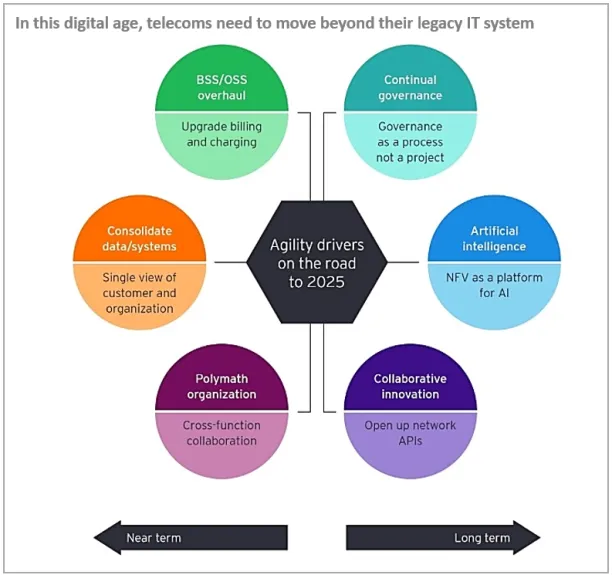The telecommunication or telecom sector is a ~$1.5 trillion market that makes communication possible worldwide. As remote work becomes more widespread, consumer needs continuously change in the telecom sector, demanding better services from telecom service providers. Like every other sector, the telecommunications sector can also benefit from digital transformation to improve its services.
In this article, we highlighted each aspect of digital transformation in the telecommunications sector, including what it is, why it matters, its benefits and challenges, and key digital technologies being used in the telecommunications industry.
What are key digital technologies in telecoms?
The following are some digital technologies that are reshaping the telecommunications sector:
Artificial intelligence and machine learning
- AI enables predictive maintenance in the telecom sector. AI and ML algorithms can identify patterns in historical data, and through algorithms, they can predict possible hardware failures.
- Conversational AI platforms such as virtual assistants and chatbots can significantly improve efficiency in the telecom sector by managing large amounts of customer queries.
Big Data
- Big data technology adds considerable value to the decision-making process and provides accurate and actionable insights for telecom companies.
- For instance, companies can use network traffic data to understand better user behavior, which can ultimately help improve the delivery of media content and the overall customer experience.
Process Mining
- Process mining collects and analyzes business processes stored in event log data generated by IT systems to provide insights into telecom operations.
- Process mining enables telecoms to monitor, manage, improve, and automate processes to accelerate digital transformation.
Internet of Things (IoT)
- Global IoT revenue is projected to increase from ~$441 billion in 2021 to ~$1 trillion by 2030.
- IoT has significant implications for improving telecom infrastructure management. It provides an intelligent platform for achieving increased efficiency and enhanced workplace experience.
- IoT can also provide data for predictive, diagnostics, and prescriptive analytics services for telecom customers.
Cloud computing
- The telecommunication cloud market will reach ~$125 billion by 2030.
- One of cloud tech’s most significant advantages is the substantial IT cost savings. In addition, cloud infrastructures can also provide the desired flexibility that telecoms need to provide ubiquitous services to their customers.
SAP Utility solutions
SAP utility solutions is a comprehensive suite of software tools to optimize utility companies’ operations, customer management, and data analytics. SAP utility solutions can help telecom industries in data integration and process management to:
- Streamline their network management
- Enhance customer service
- Improve operational efficiency.
SAP job scheduling software
SAP job scheduling software can automate the scheduling, execution, and monitoring of background jobs and tasks within SAP systems. These tools can benefit telecom industries in specific use cases such as:
- Automated billing cycles: Streamlining periodic billing processes to ensure timely and accurate invoicing.
- Data synchronization: Ensuring real-time updates across customer databases and network systems.
- Network monitoring: Scheduling regular checks and maintenance tasks to optimize network performance.
- CRM and OSS integration: Automating workflows between customer relationship management and operational support systems for better service delivery.
- Proactive maintenance: Scheduling system health checks and updates to prevent service disruptions.
Customer Information System (CIS) Utilities
Customer Information System (CIS) Utilities tools can manage customer data, billing, and service interactions for utility companies, enabling telecom industries to:
- Efficiently handle customer accounts, billing processes, and service requests
- Enhancing customer satisfaction and operational efficiency.
Large Language Models (LLMs) and Generative AI
Generative AI (GenAI) and LLMs like GPT-4 are revolutionizing telecom operations by automating complex tasks and enhancing human capabilities. These technologies go beyond traditional AI systems by generating human-like text, analyzing unstructured data, and enabling dynamic decision-making. These tools can benefit telecom industries in specific use cases such as:
- Hyper-personalized customer service: LLM-powered chatbots resolve intricate queries (e.g., contract disputes, service troubleshooting) in real-time using natural language understanding, reducing call center loads by up to 30%.
- Network optimization: GenAI simulates network configurations to predict traffic bottlenecks and recommend real-time adjustments.
- Predictive analytics: LLMs analyze customer sentiment from call logs and social media to identify churn risks and trigger retention campaigns.
- Content automation: Generative AI drafts personalized marketing emails, service updates, and technical documentation at scale, cutting content production costs by 40%.
- Fraud detection: LLMs spot anomalies in customer interactions (e.g., phishing attempts, account takeover patterns) by processing monthly support tickets.
The GenAI market in telecom is projected to grow at a 32% CAGR through 2030, driven by demand for operational efficiency and customer experience innovation.
What does digital transformation mean for telecoms?
Digital transformation in the telecommunications sector means that service providers expand and improve their services by implementing new digital technology in their business. These services include:
- Phone service
- Internet service
- Television service
- Networking for businesses and homes
What are the benefits of digital transformation for telecoms?
Benefits of digital transformation for the telecommunication companies include:
- Improved customer experience: Digital transformation can enable telecom service providers to improve customer experience through digital solutions such as digital customer relationship management and omnichannel customer care services, chatbots, and social media interactions.
- Data-driven insights: Digital technologies can analyze vast amounts of data and provide accurate insights. These insights can enable better planning and help with strategic development.
- Agile network: Digital technologies can help telecoms react to changing customer demand and stay competitive.
- Automation: Automating workflows can help reduce human errors and improve operations in the telecom sector. This can reduce failures and problems in the telecom network.
What are the challenges for telecoms?
It is challenging for telecom companies to provide quicker and more agile services as their business becomes more complex.
Some of the challenges are:
- Market integration: Previously, services such as fixed-line, broadband, and broadcasting were separate markets. Consolidating these services increases the telecom service provider’s complexity. This will become even more challenging as services such as smart cars and smart homes become common.
- OTT Services: The increasing demand for over-the-top (OTT) platforms, such as Netflix and Disney Plus, has forced telecom companies to incorporate a more flexible business model, work with new operators, and allocate revenue to new alliances. Smoothly integrating these elements into the existing model can be challenging for telecom service providers.
- Centralized to decentralized: Many new digital technologies are based on agile development. Therefore, if a telecom company has a centralized system, it can be challenging to decentralize it to implement digital solutions in different parts of its business.
How can telecoms remain competitive in the future?
The following figure illustrates the elements telecommunication companies must incorporate in their business systems to become more agile and remain competitive.
Figure 1. legacy to agility

What are some case studies of digital transformation for telecoms?
The following table presents some digital transformation case studies in the telecommunications sector:
| Type of project | Company | Business Function | Case Study | Result |
|---|---|---|---|---|
| Process Improvement | Vodafone | Customer Service | •Introduced Chatbot TOBi | •68% improvement in customer satisfaction |
| Process Improvement and innovation | AT&T | Customer Services | •AI and Machine Learning applications | •Efficient customer assistance • Optimized schedules for technicians • ML-based incident management program managed 15 million alarms per day |
| Innovation | Globe Telecom | Product and customer experience | •Implemented ML and cloud to enhance omnichannel customer experience | • Better business decision • Improved customer experience •Boosted product optimization |
| Process Improvement and innovation | Deutsche Telekom | Customer Service | •Chatbot called Tinka: Similar to a search engine | •Processes about 80% of the queries and reduces the load on employees. |
To learn more about digital transformation, you can also read:
For broader utility sector applications, such as utility asset management, SAP meter to cash process automation, and advanced metering infrastructure optimization, check out these tools:
- SAP utility solutions
- AI in utilities
- RPA in utilities
- Customer information system utilities
- Smart grid solutions
If you have questions about digital transformation in telecommunications, let us know:



Comments
Your email address will not be published. All fields are required.